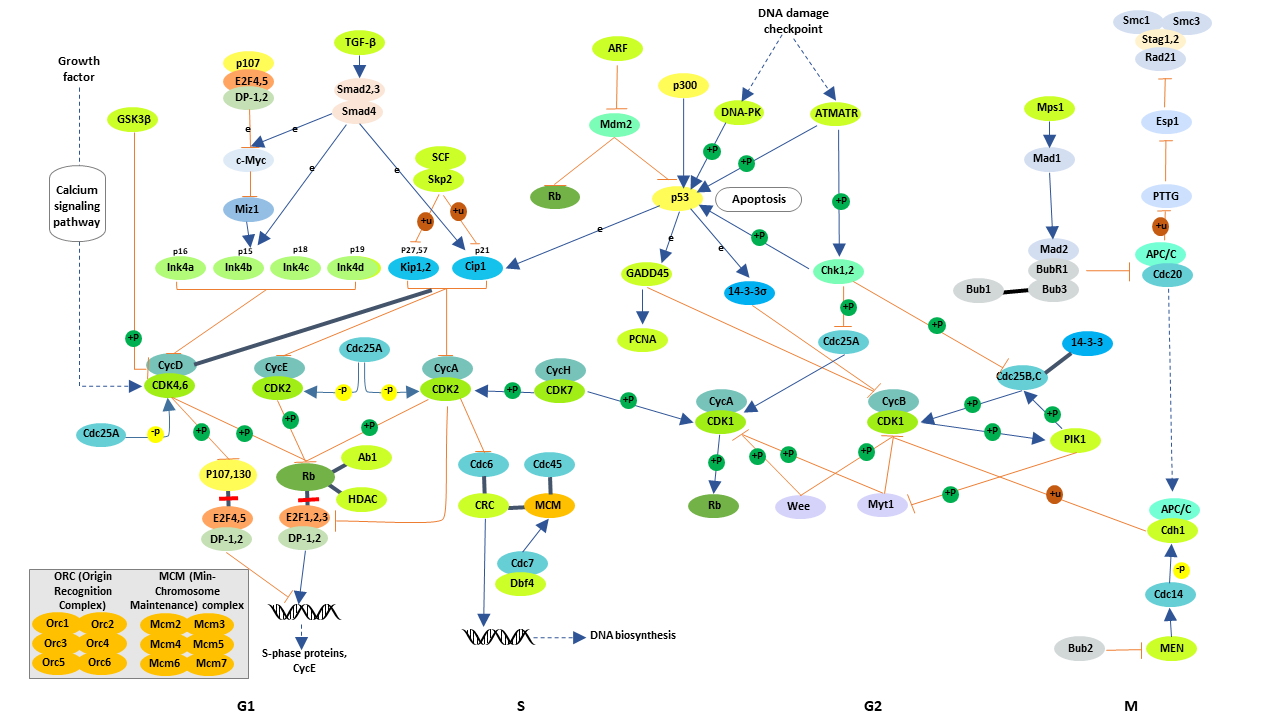
What Is the Cell Cycle?
Cell cycle, also called the cell-division cycle, refers to the process from the completion of a continuous-dividing cell's division to the end of the next division. In this biochemical process, a large amount of DNA on a chromosome in a cell are precisely duplicated, and then the copies are exactly divided into two genetically identical daughter cells.
The Function of the Cell Cycle
The cell cycle is an important process by which a single-cell fertilized egg develops into a mature organism. And the cell cycle maintains and ensures the regeneration of hair, skin, blood cells and some internal organs.
The Process of Cell Cycle
In eukaryotic cells or cells with a nucleus, the phases of the cell cycle include two main stages: the interphase and the mitotic (M) phase.
Interphase: The interphase is the duration between the end of a cell's last division and the beginning of its next division. Interphase is an important period during mitosis. And it prepares for cell division and makes the next mitosis possible. Many events take place during the interphase, such as the replication of DNA, the synthesis of related proteins, and the gradual disappearance of nuclear membrane and nucleoli. And the time of interphase counts for about 91 percent of that in cell division. Interphase comprises Gap 1 (G1) phase, Synthesis (S) phase, Gap 2 (G2) phase.
Sometimes, some cells leave the cycle and quit dividing in the adverse condition, like nutrient deprivation. These cells enter a resting phase -- G0 phase. Among these cells, some could re-enter the cycle when given adequate conditions, but some non-proliferating cells can no longer divide anymore like neuronal cells -- they have reached their final development stage. So the cells that reside in the G0 phase may be a temporary break or a permanent one.
G1: It is also called the growth phase. In the duration of the G1 phase, the organelles increase and mRNA & proteins are synthesized in the cells. And cells grow bigger. All these alterations are prepared for DNA synthesis. The checkpoint (restriction point) in the G1 phase determines whether a cell continues to divide or leaves the cycle (enter the G0 phase). If a cell successfully passes through the G1 checkpoint, it acquires the admission ticket to continue dividing. The checkpoint is regulated by G1/S cyclin, which promotes cells transition from G1 to S phase.
S: The S phase completes the synthesis of DNA and histones that involved in DNA assembly and chromatin composition. During this period, DNA amount doubles and each chromosome copies into two chromatids that joined by the centromere.
G2: G2 phase is the gap between the end of DNA replication and the beginning of mitosis. Cells synthesize certain proteins and RNA molecules to provide material for entry into mitosis during the G2 phase. The G2 checkpoint, which is mainly regulated by the tumor protein p53, examines the cell for any DNA damage within the chromosome before the cell enters the mitotic phase. Once tracking down DNA damage, p53 can repair DNA or trigger apoptosis. If p53 mutates or dysfunctions, DNA-damaged cells may continue through the cell cycle, which could lead to the development of cancer.
Mitotic (M) phase: Mitosis occurs only in eukaryotes. Prokaryotes divide by binary division due to the absence of nuclei. The M phase is complex and highly regulated. The sequence of events is divided into prophase (including prophase and prometaphase), metaphase, anaphase, and telophase. Mitosis accounts for about 10 percent of the cell cycle (may last only one to two hours) and is much shorter than the interphase. Mitotic errors can cause cell death through apoptosis or mutations that may induce cancer.
Prophase: During the Prophase, nuclear envelope disintegrates and the nucleolus disappears. Chromatin condenses into spirals to form chromosomes. And the centrosome emits star rays (in animal cells) or the cell poles send out spindle filaments (in plant cells) to form spindles. And then spindle fibers attach to the centromere of the chromosome.
Metaphase: Upon spindle fibers attaching to centromeres, they drag the chromosomes into the center of the cells, where all the chromosomes are lined up on the equator surface.
Anaphase: At this stage, centromere split, and the two sister chromatids are pulled to two poles of the cells by spindle fiber. As a result, the number of chromosomes doubles.
Telophase: The nuclear envelope reforms and nucleolus appears. Besides, chromosomes gradually decompress to form chromatin, and the spindles gradually disappear. Subsequently, cytokinesis happens, dividing the nucleus, cytoplasm, organelles, and cell membrane into two daughter cells that contain nearly equal parts of the mother cell.
Cytokinesis performs differently in animal cells and plant cells. In animal cells, a protein near the equator forms the contracting ring to pinches the cell in half, which creates shallow grooves on the surface. Because of cell walls, plant cells do not form contracting rings but build cell plates in the middle of the cells and then new cell walls regenerate in the two daughter cells.
Regulation of Eukaryotic Cell Cycle
Regulation of eukaryotic cell cycle, including the detection & repair of DNA damage and the prevention of uncontrolled cell division, is critical for cell survival. The molecular events that control the cell cycle are ordered and directed.
The realization of the cell cycle process depends on the precise and strict regulation of the cell cycle by various regulatory factors. The core of these regulatory factors is:
Cyclin-Dependent Kinase (CDK): Cyclin-Dependent Kinase inhibitor (CKI) is a negative regulatory factor of CDK, while cyclin can positively regulate CDK.
MPF (M-phase promoter factor): It is a factor that can induce interphase cells to enter the division stage in advance in M-phase cells of all eukaryotes. MPF can catalyze the subunit of CDK to remain quantity constant. And it is regulated by Cyclin. MFP accumulates and decomposes in different phases of the cell cycle.
Cell checkpoints: They primarily detect whether early cell cycle events are completed & whether the cells are intact, and monitor DNA damage or delay responses during cell cycle progression. Here list some cell checkpoints below.
● G1/S checkpoint is the rate-limiting step in the cell cycle. It is responsible for checking whether the cells have enough material to fully replicate DNA (nucleotide bases, DNA synthase, chromatin, etc.).
● S checkpoint checks whether DNA replication is complete.
● G 2 / M checkpoint is the control point at which the cell ensures that it has enough cytoplasm and phospholipids to split the cell in two. Sometimes it checks whether the replication time is correct.
● The metaphase-anaphase checkpoint is the spindle assembly test points. Failure during the centromeres attach to the spindle inhibits APC activity, resulting in disruption of the cell cycle.
Cell Cycle and Diseases
The cell cycle is associated with a variety of human diseases, especially cancer. The unrestricted proliferation of cells caused by cell cycle disorders is the main cause of cancer. At the molecular level, it is the result of gene mutations that cause inappropriate activation of cell cycle promoters and/or deactivation of inhibitors, resulting in uncontrolled cell cycle regulation.
Related Applications of Cell Cycle
Recently, some experts have designed some drugs that target to stop the formation of spindles in cells and further inhibit mitosis of cells and remain cell division in the G0 phase. The drugs effectively curb the malignant proliferation and spread of cancer cells.
For example, ordinary watermelons are diploid and produce normal seeds. Ordinary watermelons treated with colchicine can tetraploid watermelons and produce normal seeds. Due to the inhibition of colchicine in the formation of spindles, mitosis is repressed and chromosomes are stopped at the metaphase of division. In such mitosis, the chromosomes divide longitudinally, but the cells do not divide and cannot form two daughter cells, thus doubling the chromosomes. When a diploid watermelon crossbreds with a tetraploid watermelon, the triploid watermelon is produced. Since the triploid watermelon cannot distribute chromosomes equally among gametes, normal seeds cannot be obtained. This is seedless watermelon.





